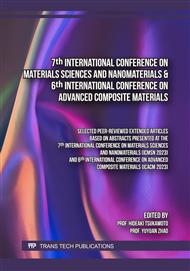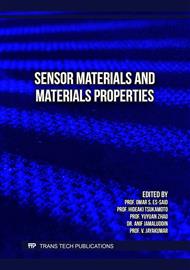[1]
Schaefer J L, Lu Y, Moganty S S, Agarwal P, Jayaprakash N and Archer L a. 2012 Electrolytes for high-energy lithium batteries Appl. Nanosci. 2 91–109
DOI: 10.1007/s13204-011-0044-x
Google Scholar
[2]
Johari N A, Kudin T I T, Ali A M M, Winie T and Yahya M Z A 2009 Studies on cellulose acetate-based gel polymer electrolytes for proton batteries Mater. Res. Innov. 13 232–4
DOI: 10.1179/143307509x440389
Google Scholar
[3]
Asghar M R, Zhang Y, Wu A, Yan X, Shen S, Ke C and Zhang J 2018 Preparation of microporous Cellulose/Poly(vinylidene fluoride-hexafluoropropylene) membrane for lithium ion batteries by phase inversion method J. Power Sources 379 197–205
DOI: 10.1016/j.jpowsour.2018.01.052
Google Scholar
[4]
Guéguen A, Streich D, He M, Mendez M, Chesneau F F, Novák P and Berg E J 2016 Decomposition of LiPF 6 in High Energy Lithium-Ion Batteries Studied with Online Electrochemical Mass Spectrometry J. Electrochem. Soc. 163 A1095–100
DOI: 10.1149/2.0981606jes
Google Scholar
[5]
Lee Y Y and Liu Y L 2017 Crosslinked electrospun poly(vinylidene difluoride) fiber mat as a matrix of gel polymer electrolyte for fast-charging lithium-ion battery Electrochim. Acta 258 1329–35
DOI: 10.1016/j.electacta.2017.11.191
Google Scholar
[6]
Liu B, Huang Y, Cao H, Song A, Lin Y, Wang M and Li X 2018 A high-performance and environment-friendly gel polymer electrolyte for lithium ion battery based on composited lignin membrane J. Solid State Electrochem. 22 807–16
DOI: 10.1007/s10008-017-3814-x
Google Scholar
[7]
Zhao X, Wang W, Huang C, Luo L, Deng Z, Guo W, Xu J and Meng Z 2021 A novel cellulose membrane from cattail fibers as separator for Li-ion batteries Cellulose 28 9309–21
DOI: 10.1007/s10570-021-04110-3
Google Scholar
[8]
Couadou E, Jacquemin J, Galiano H, Hardacre C and Anouti M 2013 A comparative study on the thermophysical properties for two bis[(trifluoromethyl)sulfonyl]imide-based ionic liquids containing the trimethyl-sulfonium or the trimethyl-ammonium cation in molecular solvents J. Phys. Chem. B 117 1389–402
DOI: 10.1021/jp308139r
Google Scholar
[9]
Wang Q, Ping P, Zhao X, Chu G, Sun J and Chen C 2012 Thermal runaway caused fire and explosion of lithium ion battery J. Power Sources 208 210–24
DOI: 10.1016/j.jpowsour.2012.02.038
Google Scholar
[10]
Fenton D E, Parker J M and Wright P V. 1973 Complexes of alkali metal ions with poly(ethylene oxide) Polymer (Guildf). 14 589
DOI: 10.1016/0032-3861(73)90146-8
Google Scholar
[11]
Wright P V. 1975 Electrical conductivity in ionic complexes of poly(ethylene oxide) Br. Polym. J. 7 319–27
Google Scholar
[12]
Zhang H and Armand M 2021 History of Solid Polymer Electrolyte-Based Solid-State Lithium Metal Batteries: A Personal Account Isr. J. Chem. 61 94–100
DOI: 10.1002/ijch.202000066
Google Scholar
[13]
Teo L P, Buraidah M H and Arof A K 2020 Polysaccharide-based polymer electrolytes for future renewable energy sources (Elsevier Inc.)
DOI: 10.1016/b978-0-12-820628-7.00011-3
Google Scholar
[14]
Chaurasia S K, Sharma A K, Singh P K, Lu L, Ni J, Savilov S V, Kuznetsov A, Polu A R, Singh A and Singh M K 2022 Structural , thermal , and electrochemical studies of biodegradable gel polymer electrolyte for electric double layer capacitor 0 1–10
DOI: 10.1177/09540083221101757
Google Scholar
[15]
M Roganda L Lumban Gaol, Roganda Sitorus, Yanthi S, Indra Surya and Renita Manurung 2013 Pembuatan Selulosa Asetat Dari Α -Selulosa Tandan Kosong Kelapa Sawit J. Tek. Kim. USU 2 33–9
DOI: 10.32734/jtk.v2i3.1447
Google Scholar
[16]
Zewde B W, Carbone L, Greenbaum S and Hassoun J 2018 A novel polymer electrolyte membrane for application in solid state lithium metal battery Solid State Ionics 317 97–102
DOI: 10.1016/j.ssi.2017.12.039
Google Scholar
[17]
Malathi J, Kumaravadivel M, Brahmanandhan G M, Hema M, Baskaran R and Selvasekarapandian S 2010 Structural, thermal and electrical properties of PVA-LiCF3SO3 polymer electrolyte J. Non. Cryst. Solids 356 2277–81
DOI: 10.1016/j.jnoncrysol.2010.08.011
Google Scholar
[18]
Wu H, Lei Y, Lu J, Zhu R, Xiao D, Jiao C, Xia R, Zhang Z, Shen G, Liu Y, Li S and Li M 2019 Effect of citric acid induced crosslinking on the structure and properties of potato starch/chitosan composite films Food Hydrocoll. 97 105208
DOI: 10.1016/j.foodhyd.2019.105208
Google Scholar
[19]
Mahalakshmi M, Selvanayagam S, Selvasekarapandian S, Moniha V, Manjuladevi R and Sangeetha P 2019 Characterization of biopolymer electrolytes based on cellulose acetate with magnesium perchlorate (Mg(ClO4)2) for energy storage devices J. Sci. Adv. Mater. Devices 4 276–84
DOI: 10.1016/j.jsamd.2019.04.006
Google Scholar
[20]
Ramesh S, Shanti R and Morris E 2013 Characterization of conducting cellulose acetate based polymer electrolytes doped with "green" ionic mixture Carbohydr. Polym. 91 14–21
DOI: 10.1016/j.carbpol.2012.07.061
Google Scholar
[21]
Kanafi N M, Rahman N A and Rosdi N H 2019 Citric acid cross-linking of highly porous carboxymethyl cellulose/poly(ethylene oxide) composite hydrogel films for controlled release applications Mater. Today Proc. 7 721–31
DOI: 10.1016/j.matpr.2018.12.067
Google Scholar
[22]
Mahdavi H and Shahalizade T 2015 Preparation, characterization and performance study of cellulose acetate membranes modified by aliphatic hyperbranched polyester J. Memb. Sci. 473 256–66
DOI: 10.1016/j.memsci.2014.09.013
Google Scholar
[23]
Arya A and Sharma A L 2018 Effect of salt concentration on dielectric properties of Li-ion conducting blend polymer electrolytes J. Mater. Sci. Mater. Electron. 29 17903–20
DOI: 10.1007/s10854-018-9905-3
Google Scholar
[24]
Sudaryanto, Yulianti E, Deswita, Wahyudianingsih, Anggreyni D N P and Kartini E 2019 Interfacial properties of solid polymer electrolyte for lithium-ion battery IOP Conf. Ser. Mater. Sci. Eng. 553 012061
DOI: 10.1088/1757-899x/553/1/012061
Google Scholar
[25]
Ghiya V P, Dave V, Gross R A and Mccarthy S P 1996 Biodegradability of cellulose acetate plasticized with citrate esters J. Macromol. Sci. - Pure Appl. Chem. 33 627–38
DOI: 10.1080/10601329608010883
Google Scholar
[26]
Lehmann M L, Yang G, Nanda J and Saito T 2020 Well-designed Crosslinked Polymer Electrolyte Enables High Ionic Conductivity and Enhanced Salt Solvation J. Electrochem. Soc. 167 070539
DOI: 10.1149/1945-7111/ab7c6e
Google Scholar



